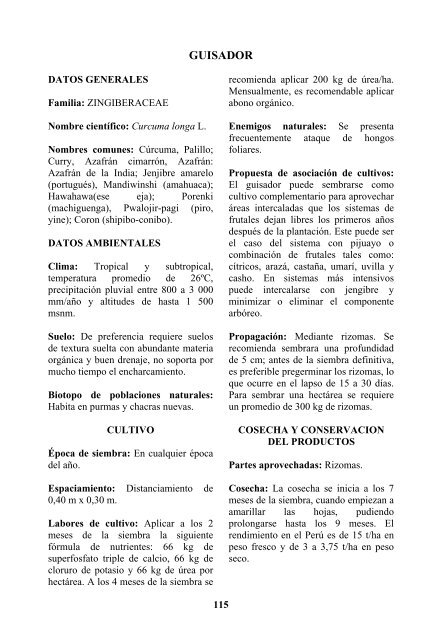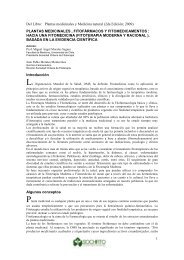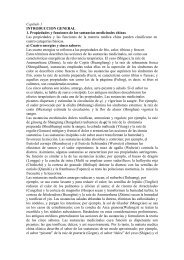Plantas medicinales de la Amazonia Peruana
Plantas medicinales de la Amazonia Peruana
Plantas medicinales de la Amazonia Peruana
You also want an ePaper? Increase the reach of your titles
YUMPU automatically turns print PDFs into web optimized ePapers that Google loves.
DATOS GENERALES<br />
Familia: ZINGIBERACEAE<br />
Nombre científico: Curcuma longa L.<br />
Nombres comunes: Cúrcuma, Palillo;<br />
Curry, Azafrán cimarrón, Azafrán:<br />
Azafrán <strong>de</strong> <strong>la</strong> India; Jenjibre amarelo<br />
(portugués), Mandiwinshi (amahuaca);<br />
Hawahawa(ese eja); Porenki<br />
(machiguenga), Pwalojir-pagi (piro,<br />
yine); Coron (shipibo-conibo).<br />
DATOS AMBIENTALES<br />
Clima: Tropical y subtropical,<br />
temperatura promedio <strong>de</strong> 26ºC,<br />
precipitación pluvial entre 800 a 3 000<br />
mm/año y altitu<strong>de</strong>s <strong>de</strong> hasta 1 500<br />
msnm.<br />
Suelo: De preferencia requiere suelos<br />
<strong>de</strong> textura suelta con abundante materia<br />
orgánica y buen drenaje, no soporta por<br />
mucho tiempo el encharcamiento.<br />
Biotopo <strong>de</strong> pob<strong>la</strong>ciones naturales:<br />
Habita en purmas y chacras nuevas.<br />
CULTIVO<br />
Época <strong>de</strong> siembra: En cualquier época<br />
<strong>de</strong>l año.<br />
Espaciamiento: Distanciamiento <strong>de</strong><br />
0,40 m x 0,30 m.<br />
Labores <strong>de</strong> cultivo: Aplicar a los 2<br />
meses <strong>de</strong> <strong>la</strong> siembra <strong>la</strong> siguiente<br />
fórmu<strong>la</strong> <strong>de</strong> nutrientes: 66 kg <strong>de</strong><br />
superfosfato triple <strong>de</strong> calcio, 66 kg <strong>de</strong><br />
cloruro <strong>de</strong> potasio y 66 kg <strong>de</strong> úrea por<br />
hectárea. A los 4 meses <strong>de</strong> <strong>la</strong> siembra se<br />
GUISADOR<br />
115<br />
recomienda aplicar 200 kg <strong>de</strong> úrea/ha.<br />
Mensualmente, es recomendable aplicar<br />
abono orgánico.<br />
Enemigos naturales: Se presenta<br />
frecuentemente ataque <strong>de</strong> hongos<br />
foliares.<br />
Propuesta <strong>de</strong> asociación <strong>de</strong> cultivos:<br />
El guisador pue<strong>de</strong> sembrarse como<br />
cultivo complementario para aprovechar<br />
áreas interca<strong>la</strong>das que los sistemas <strong>de</strong><br />
frutales <strong>de</strong>jan libres los primeros años<br />
<strong>de</strong>spués <strong>de</strong> <strong>la</strong> p<strong>la</strong>ntación. Este pue<strong>de</strong> ser<br />
el caso <strong>de</strong>l sistema con pijuayo o<br />
combinación <strong>de</strong> frutales tales como:<br />
cítricos, arazá, castaña, umarí, uvil<strong>la</strong> y<br />
casho. En sistemas más intensivos<br />
pue<strong>de</strong> interca<strong>la</strong>rse con jengibre y<br />
minimizar o eliminar el componente<br />
arbóreo.<br />
Propagación: Mediante rizomas. Se<br />
recomienda sembrara una profundidad<br />
<strong>de</strong> 5 cm; antes <strong>de</strong> <strong>la</strong> siembra <strong>de</strong>finitiva,<br />
es preferible pregerminar los rizomas, lo<br />
que ocurre en el <strong>la</strong>pso <strong>de</strong> 15 a 30 días.<br />
Para sembrar una hectárea se requiere<br />
un promedio <strong>de</strong> 300 kg <strong>de</strong> rizomas.<br />
COSECHA Y CONSERVACION<br />
DEL PRODUCTOS<br />
Partes aprovechadas: Rizomas.<br />
Cosecha: La cosecha se inicia a los 7<br />
meses <strong>de</strong> <strong>la</strong> siembra, cuando empiezan a<br />
amaril<strong>la</strong>r <strong>la</strong>s hojas, pudiendo<br />
prolongarse hasta los 9 meses. El<br />
rendimiento en el Perú es <strong>de</strong> 15 t/ha en<br />
peso fresco y <strong>de</strong> 3 a 3,75 t/ha en peso<br />
seco.






